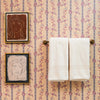Q: Does linen fabric shrink when washed?
A: Yes indeed, following the first wash, linen cloth might shrink by about 3-4%. This is a result of the linen's inherent fibers contracting in the presence of heat and moisture. It is crucial to wash linen in cold water and steer clear of excessive heat when drying it to reduce shrinkage. The easiest way to preserve the fabric's original texture and size is to air dry it. Furthermore, it is common to find pre-washed or pre-shrunk linen, which lessens the likelihood of obvious shrinking following the first wash.
Q: What is linen fabric made of?
A: Flax fibers, more especially the long cellulose fibers found inside the plant's stalks, are used to make linen fabric. These fibers are removed from the woody portions of the flax plant through a labor-intensive procedure called retting. The fibers are retted, spun into yarn, and then woven into cloth. Because flax fibers are stronger and thicker than cotton fibers, linen is known for its exceptional resilience, texture, and organic feel.
Q: What type of fabric is linen?
A: The fibers of the flax plant are used to make linen, a naturally occurring fabric derived from plants. It is classified as a bast fiber, which means that, in contrast to cotton, it is obtained from the stalk of a plant rather than the seed. The textured weave, crisp feel, and opulent appearance of linen are well-known. It is regarded as eco-friendly and biodegradable. Since linen is a natural material, it differs from synthetic materials like polyester. In fact, when compared to cotton, linen is frequently seen to be a more enduring, breathable, and environmentally friendly choice.
Q: Is linen fabric good for hot weather?
A: It sure is! Because of its moisture-wicking qualities and breathability, linen is among the greatest materials for hot weather. Because of its loosely woven threads, linen promotes better ventilation, which helps you stay cool and regulate your body temperature. Additionally, it effectively absorbs moisture, removing perspiration from the skin and accelerating drying. Because of these characteristics, linen is a popular material for summer apparel, bedding, and even accessories like hats and scarves. In contrast to synthetic materials that have the potential to retain heat and moisture, linen stays airy and comfortable even in hot weather.
Q: How long does linen fabric last?
A: With the right maintenance, linen is an incredibly resilient fabric that can last for decades. Being among the strongest natural fibers, it gains strength when damp, making it resilient to abrasions and tearing. Though initially stiff, linen becomes softer after every wash, enhancing its comfort level without sacrificing its durability. In contrast to other materials that may deteriorate or weaken with time, linen ages more elegantly, becoming smoother and more elegant-looking. It is important to follow the right washing, drying, and storing procedures to guarantee its longevity.
Q: Is linen fabric sustainable?
A: One of the most ecological materials out there is thought to be linen. The cultivation of flax takes fewer resources than that of crops like cotton because it needs a lot less water and insecticides. Flax is frequently used in crop rotation to maintain soil health since it can grow in unfavorable soil conditions and does not deplete the land's nutrients. Furthermore, linen is completely biodegradable, so it will not add to environmental garbage over time. Because of its strength, linen products also last longer, which minimizes textile waste over time and lessens the need for regular replacements.































